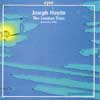Haydn (The) London Trios
Haydn on a domestic scale, a well-planned programme but not a full recommendation
View record and artist detailsRecord and Artist Details
Composer or Director: Joseph Haydn
Genre:
Chamber
Label: CPO
Magazine Review Date: 10/2004
Media Format: CD or Download
Media Runtime: 71
Mastering:
Stereo
DDD
Catalogue Number: CPO999 920-2

Tracks:
| Composition | Artist Credit |
|---|---|
| Keyboard Trio No. 15 |
Joseph Haydn, Composer
Camerata Köln Joseph Haydn, Composer |
| Keyboard Trio No. 16 |
Joseph Haydn, Composer
Camerata Köln Joseph Haydn, Composer |
| Keyboard Trio No. 17 |
Joseph Haydn, Composer
Camerata Köln Joseph Haydn, Composer |
| (4) Trios for 2 Flutes and Cello |
Joseph Haydn, Composer
Camerata Köln Joseph Haydn, Composer |
Author: Nalen Anthoni
A flute rather than a violin was the treble instrument for Nos 15-17 of Haydn’s 29 authenticated keyboard trios. London publisher John Bland commissioned them in 1790, and since they would have been classified as ‘accompanied sonatas’ they were probably composed for what musicologist Simon McVeigh calls the ‘amateur domestic medium’ – women, who did not participate in public concerts. Haydn specifically named four as dedicatees of his remaining 12 trios.
In the booklet-note Andreas Friesenhagen says that Bland offered the alternative of a violin for No 17 only, but Camerata Köln (on period instruments) stick to the original specification. The intended venues might have been small but the piano writing in all three trios is wide-ranging; and Sabine Bauer is an assertive fortepianist. Not that she drowns her partners (the balance is right, with the cello given its due), but her playing is mostly literal. She can sometimes unbend to considerable advantage, as in the first movement development of No 15 that has fine distinctions in articulation, but usually she is tonally and rhythmically monotonous.
The trios for two flutes (here placed antiph-onally but with a slight breathiness to the left instrument) and cello are thought by Friesenhagen to have been written for the Earl of Abingdon and Sir Walter Aston during Haydn’s second visit to England. They are small-scale pieces but the musicians accord them respect with tasteful phrasing and a variety of expression. A thoughtfully planned programme but, regretfully, a reserved recommendation.
In the booklet-note Andreas Friesenhagen says that Bland offered the alternative of a violin for No 17 only, but Camerata Köln (on period instruments) stick to the original specification. The intended venues might have been small but the piano writing in all three trios is wide-ranging; and Sabine Bauer is an assertive fortepianist. Not that she drowns her partners (the balance is right, with the cello given its due), but her playing is mostly literal. She can sometimes unbend to considerable advantage, as in the first movement development of No 15 that has fine distinctions in articulation, but usually she is tonally and rhythmically monotonous.
The trios for two flutes (here placed antiph-onally but with a slight breathiness to the left instrument) and cello are thought by Friesenhagen to have been written for the Earl of Abingdon and Sir Walter Aston during Haydn’s second visit to England. They are small-scale pieces but the musicians accord them respect with tasteful phrasing and a variety of expression. A thoughtfully planned programme but, regretfully, a reserved recommendation.
Discover the world's largest classical music catalogue with Presto Music.

Gramophone Digital Club
- Digital Edition
- Digital Archive
- Reviews Database
- Full website access
From £8.75 / month
Subscribe
Gramophone Full Club
- Print Edition
- Digital Edition
- Digital Archive
- Reviews Database
- Full website access
From £11.00 / month
Subscribe
If you are a library, university or other organisation that would be interested in an institutional subscription to Gramophone please click here for further information.




